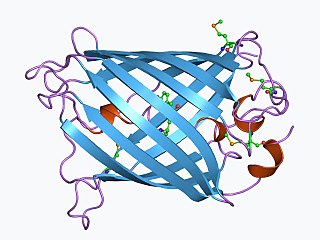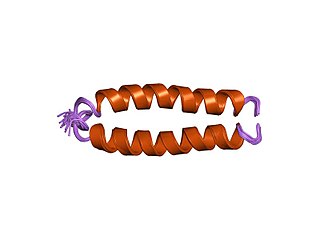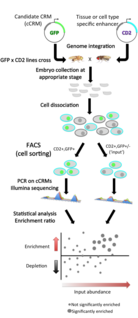Synthetic morphology is a sub-discipline of the broader field of synthetic biology.

Synthetic biology is an interdisciplinary branch of biology and engineering.
In standard synthetic biology, artificial gene networks are introduced into cells, inputs (e.g. chemicals, light) are applied to those networks, and the networks perform logical operations on them and output the result of the operation as the activity of an enzyme or as the amount of green fluorescent protein. Using this approach, synthetic biologists have demonstrated the ability of their gene networks to perform Boolean computation, to hold a memory, and to generate pulses and oscillation.

The cell is the basic structural, functional, and biological unit of all known living organisms. A cell is the smallest unit of life. Cells are often called the "building blocks of life". The study of cells is called cell biology.

Enzymes are macromolecular biological catalysts. Enzymes accelerate chemical reactions. The molecules upon which enzymes may act are called substrates and the enzyme converts the substrates into different molecules known as products. Almost all metabolic processes in the cell need enzyme catalysis in order to occur at rates fast enough to sustain life. Metabolic pathways depend upon enzymes to catalyze individual steps. The study of enzymes is called enzymology and a new field of pseudoenzyme analysis has recently grown up, recognising that during evolution, some enzymes have lost the ability to carry out biological catalysis, which is often reflected in their amino acid sequences and unusual 'pseudocatalytic' properties.

The green fluorescent protein (GFP) is a protein composed of 238 amino acid residues that exhibits bright green fluorescence when exposed to light in the blue to ultraviolet range. Although many other marine organisms have similar green fluorescent proteins, GFP traditionally refers to the protein first isolated from the jellyfish Aequorea victoria. The GFP from A. victoria has a major excitation peak at a wavelength of 395 nm and a minor one at 475 nm. Its emission peak is at 509 nm, which is in the lower green portion of the visible spectrum. The fluorescence quantum yield (QY) of GFP is 0.79. The GFP from the sea pansy has a single major excitation peak at 498 nm. GFP makes for an excellent tool in many forms of biology due to its ability to form internal chromophore without requiring any accessory cofactors, gene products, or enzymes / substrates other than molecular oxygen.
Synthetic morphology extends this idea by adding output modules that alter the shape or social behaviour of cells in response to the state of the artificial gene network. For example, instead of just making a fluorescent protein, a gene network may switch on an adhesion molecule so that cells stick to each other, or activate a motility system so that cells move. It has been argued that the formation of properly-shaped tissues by mammalian cells involves mainly a set of about ten basic cellular events (cell proliferation, cell death, cell adhesion, differential adhesion, cell de-adhesion, cell fusion, cell locomotion, chemotaxis, haptotaxis, cell wedging). [1] Broadly similar lists exist for tissues of plants, fungi etc. In principle, therefore, a fairly small set of output modules might allow biotechnologists to 'program' cells to produce artificially-designed arrangements, shapes and eventually 'tissues'.

Motility is the ability of an organism to move independently, using metabolic energy. This is in contrast to mobility, which describes the ability of an object to be moved. Motility is genetically determined, but may be affected by environmental factors. For instance, muscles give animals motility but the consumption of hydrogen cyanide would adversely affect muscle physiology, causing them to stiffen, leading to rigor mortis. In addition to animal locomotion, most animals are motile – the term applies to bacteria and other microorganisms, and to some multicellular organisms, as well as to some mechanisms of fluid flow in multicellular organs and tissue. Motile marine animals are commonly called free-swimming, and motile non-parasitic organisms are called free-living.
The term synthetic morphology was introduced to the peer reviewed scientific literature in 2008 [1] and is now becoming more widely used both in peer-reviewed literature [2] and texts. [3]

Peer review is the evaluation of work by one or more people with similar competences as the producers of the work (peers). It functions as a form of self-regulation by qualified members of a profession within the relevant field. Peer review methods are used to maintain quality standards, improve performance, and provide credibility. In academia, scholarly peer review is often used to determine an academic paper's suitability for publication. Peer review can be categorized by the type of activity and by the field or profession in which the activity occurs, e.g., medical peer review.







